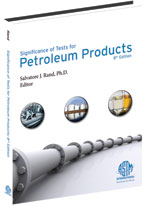
Petroleum Product Tests
Which Tests to Use and Why
The ASTM Dudley Medal-winning Manual 1, Significance of Tests for Petroleum Products, now in its 8th edition, encapsulates "what tests we do and why we do them," according to editor Salvatore J. Rand, Ph.D., a petroleum industry consultant and long-time member of ASTM International Committee on Petroleum Products and Lubricants.
The manual addresses the latest analytical procedures and specifications used to describe a quality petroleum product, which is defined as one that meets agreed-upon specifications. In the book, readers will find information about the standards pertaining to petroleum products in use today, including those characterizing a quality gasoline, aviation fuel or diesel fuel; why the tests are performed and what significant considerations exist regarding the properties and use of the product.
This is the second edition of Manual 1 that Rand has overseen. (ASTM originally published the work in 1928 as Special Technical Publication 7.) When the project to update the 6th edition came up at a D02 executive meeting, Rand agreed to the job because he used the manual regularly while director of the Texaco Fuels Test Lab. Now, in teaching two ASTM petroleum-related training courses worldwide, Rand meets people who use the book regularly, and he has even been asked to autograph their copies.
Earlier manual editions considered bulk properties (gravity, corrosion, etc.) and wet chemical tests (saponification, aniline point, bromine number etc.), according to Rand. The new edition updates all chapters and deals mainly with instrumental test methods; some older tests are discussed, but mostly ones that use automatic equipment.
The latest manual edition reflects products and new test procedures now available, and this 8th edition includes three new chapters:
- Biodiesel - This renewable fuel supplements traditional petroleum products, and the chapter, in response to worldwide interest in biofuels, reviews the state of the art in biodiesel standards and methods.
- Synthetic Liquid Fuels - Continuing interest in decreasing dependence on petroleum fuels derived from crude oil has led to alternatives manufactured from chemical products, with the standards under current development in Committee D02 described in this chapter.
- Determination of Inorganic Species in Petroleum Products and Lubricants - New problems arising from small quantities of inorganic materials require tests that measure even smaller amounts (just a few parts per million) of inorganics. For example, decreasing fuel sulfur levels produces elemental sulfur and mercaptans that attack the alloys on the gasoline metering sensors in gas tanks, causing inaccurate readings of fuel quantity and, at times, resulting in highway accidents.
A resource useful for those who have spent many years in the petroleum industry as well as those new to the field, Manual 1 considers such significant steps as sampling and quality assurance. Rand says, "I call sampling the first step in the analysis. If you don't take a good sample, you can have analytical instruments costing millions of dollars, but you're not going to get a good result." The book also covers measurements for data quality assurance and discusses ASTM standards that lead to quality improvement.
Each chapter ends with a list of referenced ASTM standards plus cross references for selected methods from such groups as the American Petroleum Institute, Deutsches Institut für Normung, the Energy Institute (formerly the Institute of Petroleum), the International Organization for Standardization (ISO) and more.
The 8th edition of Manual 1 will assist buyers and sellers in agreeing on what constitutes a quality petroleum product and what standards can verify that quality.
 SN Home
SN Home Archive
Archive Advertisers
Advertisers Masthead
Masthead RateCard
RateCard Subscribe
Subscribe Email Editor
Email Editor